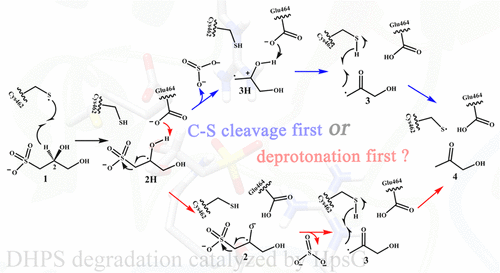当前位置:
X-MOL 学术
›
J. Chem. Inf. Model.
›
论文详情
Our official English website, www.x-mol.net, welcomes your
feedback! (Note: you will need to create a separate account there.)
Mechanistic Insights into the Anaerobic Degradation of Globally Abundant Dihydroxypropanesulfonate Catalyzed by the DHPS-Sulfolyase (HpsG)
Journal of Chemical Information and Modeling ( IF 5.6 ) Pub Date : 2022-05-18 , DOI: 10.1021/acs.jcim.2c00174 Lijuan Yan 1 , Yongjun Liu 1
Journal of Chemical Information and Modeling ( IF 5.6 ) Pub Date : 2022-05-18 , DOI: 10.1021/acs.jcim.2c00174 Lijuan Yan 1 , Yongjun Liu 1
Affiliation

|
2(S)-Dihydroxypropanesulfonate (DHPS) is the main abundant organosulfonate in the biosphere generated by the microbial degradation of the abundant organosulfur species 6-deoxy-6-sulfo-d-glucopyranose (sulfoquinovose, SQ). Massive amounts of DHPS can also be produced by the highly abundant oceanic diatoms. The quantity of degradation DHPS is so large that it has become an important part of the earth’s sulfur. The recently characterized O2-sensitive glycyl radical enzyme DHPS-sulfolyase HpsG in anaerobic bacteria was found to be capable of cleaving the C–S bond of DHPS under anaerobic conditions. However, the detailed degradation mechanism is still unclear. Here, on the basis of the crystal structure of HpsG, we constructed the computational model and performed QM/MM calculations to illuminate the anaerobic degradation mechanism of DHPS. Our calculations revealed that the degradation reaction follows an unusual radical-dependent mechanism that does not require a conserved Glu464 to deprotonate the C2 hydroxyl of substrate to promote the C–S cleavage; instead, after the first hydrogen abstraction triggered by the thiyl radical (Cys462), the C–S bond in 2(S)-dihydroxypropanesulfonate can directly collapse. Thus, conserved Glu464 mainly plays a role in stabilizing the substrate and reaction intermediate by forming a hydrogen bond. After the release of the sulfonic acid group from the protein environment, the deprotonated Glu464 spontaneously accepts a proton from the C2 hydroxyl of the substrate radical. Our findings clarified an unusual C–S cleavage mechanism involved in the DHPS degradation reaction catalyzed by GREs.
中文翻译:

DHPS-磺基解酶 (HpsG) 催化全球丰富的二羟基丙磺酸盐厌氧降解的机理研究
2(小号)-二羟基丙磺酸盐 (DHPS) 是生物圈中主要的丰富有机磺酸盐,由丰富的有机硫物种 6-deoxy-6-sulfo-d-glucopyranose (sulfoquinovose, SQ) 的微生物降解产生。丰富的海洋硅藻也可以产生大量的DHPS。DHPS的降解量如此之大,已成为地球硫磺的重要组成部分。最近发现在厌氧菌中对 O2 敏感的甘氨酰自由基酶 DHPS-磺基解酶 HpsG 能够在厌氧条件下裂解 DHPS 的 C-S 键。然而,详细的降解机制仍不清楚。在此,基于HpsG的晶体结构,我们构建了计算模型并进行了QM/MM计算,以阐明DHPS的厌氧降解机理。我们的计算表明,降解反应遵循一种不寻常的自由基依赖性机制,不需要保守的 Glu464 使底物的 C2 羟基去质子化以促进 C-S 裂解。相反,在由硫自由基(Cys462)触发的第一次夺氢后,2中的C-S键(S )-二羟基丙磺酸盐可以直接塌陷。因此,保守的Glu464主要通过形成氢键来稳定底物和反应中间体。在从蛋白质环境中释放磺酸基团后,去质子化的 Glu464 自发地接受来自底物自由基的 C2 羟基的质子。我们的研究结果阐明了与 GRE 催化的 DHPS 降解反应有关的不寻常的 C-S 裂解机制。
更新日期:2022-05-18
中文翻译:

DHPS-磺基解酶 (HpsG) 催化全球丰富的二羟基丙磺酸盐厌氧降解的机理研究
2(小号)-二羟基丙磺酸盐 (DHPS) 是生物圈中主要的丰富有机磺酸盐,由丰富的有机硫物种 6-deoxy-6-sulfo-d-glucopyranose (sulfoquinovose, SQ) 的微生物降解产生。丰富的海洋硅藻也可以产生大量的DHPS。DHPS的降解量如此之大,已成为地球硫磺的重要组成部分。最近发现在厌氧菌中对 O2 敏感的甘氨酰自由基酶 DHPS-磺基解酶 HpsG 能够在厌氧条件下裂解 DHPS 的 C-S 键。然而,详细的降解机制仍不清楚。在此,基于HpsG的晶体结构,我们构建了计算模型并进行了QM/MM计算,以阐明DHPS的厌氧降解机理。我们的计算表明,降解反应遵循一种不寻常的自由基依赖性机制,不需要保守的 Glu464 使底物的 C2 羟基去质子化以促进 C-S 裂解。相反,在由硫自由基(Cys462)触发的第一次夺氢后,2中的C-S键(S )-二羟基丙磺酸盐可以直接塌陷。因此,保守的Glu464主要通过形成氢键来稳定底物和反应中间体。在从蛋白质环境中释放磺酸基团后,去质子化的 Glu464 自发地接受来自底物自由基的 C2 羟基的质子。我们的研究结果阐明了与 GRE 催化的 DHPS 降解反应有关的不寻常的 C-S 裂解机制。











































 京公网安备 11010802027423号
京公网安备 11010802027423号